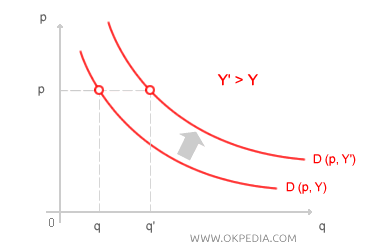Shifts in Demand
Shifts in demand refer to changes in a product's demand schedule caused by factors other than the product's own price. These movements of the demand curve, also known as "shifts," are influenced by key factors such as income levels and the prices of substitute and complementary goods. In a partial equilibrium analysis, these variables are typically held constant.
- Changes in Income. When a consumer's income changes, so does their purchasing power. An increase in income expands the consumer's budget constraint, enabling them to buy more goods. Consequently, the demand curve shifts to the right. Conversely, a decrease in income reduces their ability to purchase goods, shifting the demand curve to the left.

- Changes in the Prices of Substitute Goods. Substitute goods are products that can replace each other to satisfy the same need. A price drop in a substitute good alters relative prices in favor of the substitute, making it more appealing. For example, if tea becomes cheaper, some consumers might choose tea over coffee, and vice versa. The price of substitutes directly affects the demand for the original good.
- Changes in the Prices of Complementary Goods. Complementary goods are products consumed together. For instance, fuel complements a car, and sugar complements coffee. When the price of fuel rises, it indirectly decreases the demand for cars, and vice versa. The price of complementary goods directly influences the demand for the associated good.
- Changes in Preferences. The demand curve can shift in position and slope due to variations in consumer preferences. A change in preferences results in a new demand schedule and new relationships between the price and the quantities demanded of the good.
https://www.okpedia.com/shifts-in-demand
Have a question? Leave it in the comments and we'll answer on this page.
